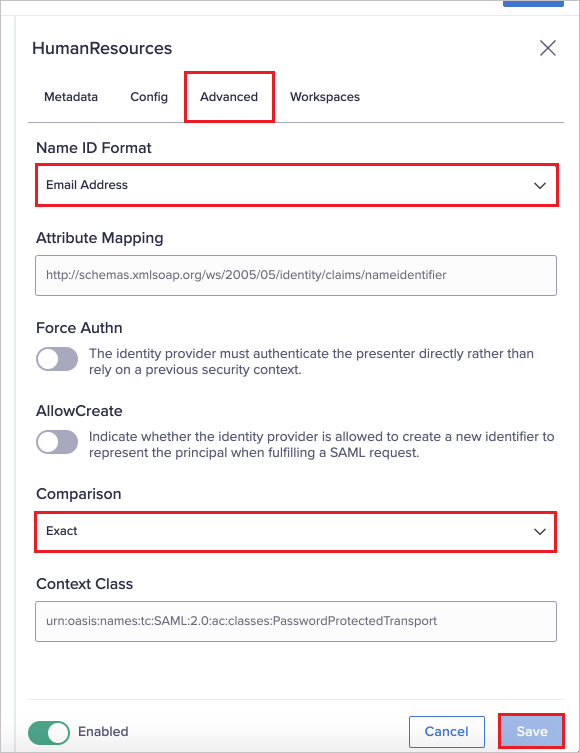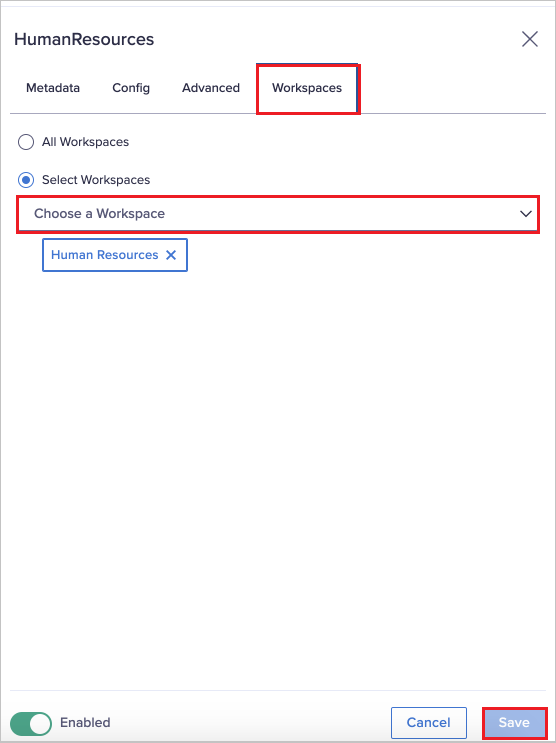Tutorial: Microsoft Entra SSO integration with Anaplan
In this tutorial, you'll learn how to integrate Anaplan with Microsoft Entra ID. When you integrate Anaplan with Microsoft Entra ID, you can:
- Control in Microsoft Entra ID who has access to Anaplan.
- Enable your users to be automatically signed-in to Anaplan with their Microsoft Entra accounts.
- Manage your accounts in one central location.
Prerequisites
To get started, you need the following items:
- A Microsoft Entra subscription. If you don't have a subscription, you can get a free account.
- Anaplan single sign-on (SSO) enabled subscription.
Scenario description
In this tutorial, you configure and test Microsoft Entra single sign-on in a test environment.
- Anaplan supports SP initiated SSO.
Add Anaplan from the gallery
To configure the integration of Anaplan into Microsoft Entra ID, you need to add Anaplan from the gallery to your list of managed SaaS apps.
- Sign in to the Microsoft Entra admin center as at least a Cloud Application Administrator.
- Browse to Identity > Applications > Enterprise applications > New application.
- In the Add from the gallery section, type Anaplan in the search box.
- Select Anaplan from results panel and then add the app. Wait a few seconds while the app is added to your tenant.
Alternatively, you can also use the Enterprise App Configuration Wizard. In this wizard, you can add an application to your tenant, add users/groups to the app, assign roles, as well as walk through the SSO configuration as well. Learn more about Microsoft 365 wizards.
Configure and test Microsoft Entra SSO for Anaplan
Configure and test Microsoft Entra SSO with Anaplan using a test user called B.Simon. For SSO to work, you need to establish a link relationship between a Microsoft Entra user and the related user in Anaplan.
To configure and test Microsoft Entra SSO with Anaplan, perform the following steps:
- Configure Microsoft Entra SSO - to enable your users to use this feature.
- Create a Microsoft Entra test user - to test Microsoft Entra single sign-on with B.Simon.
- Assign the Microsoft Entra test user - to enable B.Simon to use Microsoft Entra single sign-on.
- Configure Anaplan SSO - to configure the single sign-on settings on application side.
- Create Anaplan test user - to have a counterpart of B.Simon in Anaplan that is linked to the Microsoft Entra representation of user.
- Test SSO - to verify whether the configuration works.
Configure Microsoft Entra SSO
Follow these steps to enable Microsoft Entra SSO.
Sign in to the Microsoft Entra admin center as at least a Cloud Application Administrator.
Browse to Identity > Applications > Enterprise applications > Anaplan > Single sign-on.
On the Select a single sign-on method page, select SAML.
On the Set up Single Sign-On with SAML page, in the SAML Signing Certificate section, click the copy icon to copy the App Federation Metadata URL and save this to use in the Anaplan SSO configuration.

Configure Anaplan SSO
Log in to Anaplan website as an administrator.
In the Administration page, navigate to Security > Single Sign-On.
Click New.
Perform the following steps in the Metadata tab:

a. Enter a Connection Name, should match the name of your connection in the identity provider interface.
b. Select Load from XML file and paste the App Federation Metadata URL you into the Metadata URL textbox.
c. Click Save to create the connection.
d. Enable the connection by setting the Enabled toggle.
From the Config tab, copy the following values to save them back to the Azure portal:
a. Service Provider URL. b. Assertion Consumer Service URL. c. Entity ID.
Complete the Microsoft Entra SSO Configuration
On the Set up single sign-on with SAML page, click the pencil icon for Basic SAML Configuration to edit the settings.

On the Basic SAML Configuration section, perform the following steps:
a. In the Identifier (Entity ID) text box, paste the Entity ID that you copied from above, in the format:
https://sdp.anaplan.com/<optional extension>b. In the Sign on URL text box, paste the Service Provider URL that you copied from above, in the format:
https://us1a.app.anaplan.com/samlsp/<connection name>c. In the Reply URL (Assertion Consumer Service URL) text box, paste the Assertion Consumer Service URL that you copied from above, in the format:
https://us1a.app.anaplan.com/samlsp/login/callback?connection=<connection name>
Complete the Anaplan SSO Configuration
Perform the following steps in the Advanced tab:

a. Select Name ID Format as Email Address from the dropdown and keep the remaining values as default.
b. Click Save.
In the Workspaces tab, specify the workspaces that will use the identity provider from the dropdown and Click Save.

Note
Workspace connections are unique. If you have another connection already configured with a workspace, you cannot associate that workspace with a new connection. To access the original connection and update it, remove the workspace from the connection and then reassociate it with the new connection.
Create a Microsoft Entra test user
In this section, you'll create a test user called B.Simon.
- Sign in to the Microsoft Entra admin center as at least a User Administrator.
- Browse to Identity > Users > All users.
- Select New user > Create new user, at the top of the screen.
- In the User properties, follow these steps:
- In the Display name field, enter
B.Simon. - In the User principal name field, enter the username@companydomain.extension. For example,
B.Simon@contoso.com. - Select the Show password check box, and then write down the value that's displayed in the Password box.
- Select Review + create.
- In the Display name field, enter
- Select Create.
Assign the Microsoft Entra test user
In this section, you'll enable B.Simon to use single sign-on by granting access to Anaplan.
- Sign in to the Microsoft Entra admin center as at least a Cloud Application Administrator.
- Browse to Identity > Applications > Enterprise applications > Anaplan.
- In the app's overview page, select Users and groups.
- Select Add user/group, then select Users and groups in the Add Assignment dialog.
- In the Users and groups dialog, select B.Simon from the Users list, then click the Select button at the bottom of the screen.
- If you are expecting a role to be assigned to the users, you can select it from the Select a role dropdown. If no role has been set up for this app, you see "Default Access" role selected.
- In the Add Assignment dialog, click the Assign button.
Create Anaplan test user
In this section, you create a user called Britta Simon in Anaplan. Work with Anaplan support team to add the users in the Anaplan platform. Users must be created and activated before you use single sign-on.
Test SSO
In this section, you test your Microsoft Entra single sign-on configuration with following options.
Click on Test this application, this will redirect to Anaplan Sign-on URL where you can initiate the login flow.
Go to Anaplan Sign-on URL directly and initiate the login flow from there.
You can use Microsoft My Apps. When you click the Anaplan tile in the My Apps, this will redirect to Anaplan Sign-on URL. For more information about the My Apps, see Introduction to the My Apps.
Next steps
Once you configure Anaplan you can enforce session control, which protects exfiltration and infiltration of your organization’s sensitive data in real time. Session control extends from Conditional Access. Learn how to enforce session control with Microsoft Defender for Cloud Apps.
Feedback
Coming soon: Throughout 2024 we will be phasing out GitHub Issues as the feedback mechanism for content and replacing it with a new feedback system. For more information see: https://aka.ms/ContentUserFeedback.
Submit and view feedback for